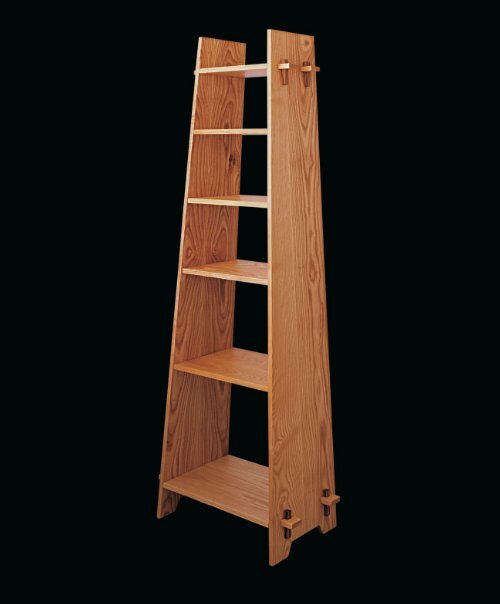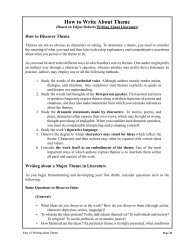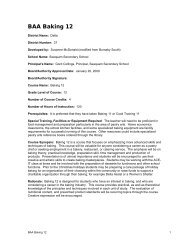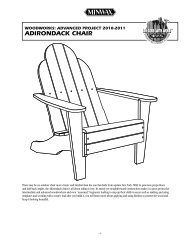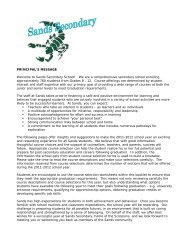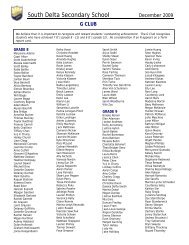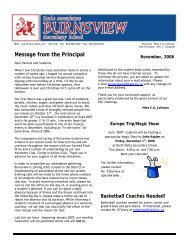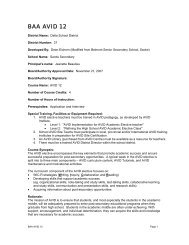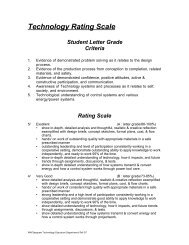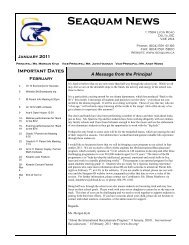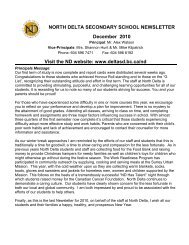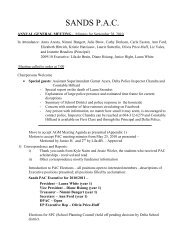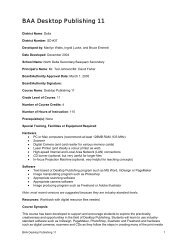Trapezoidal Bookcase
Trapezoidal Bookcase
Trapezoidal Bookcase
Create successful ePaper yourself
Turn your PDF publications into a flip-book with our unique Google optimized e-Paper software.
<strong>Trapezoidal</strong> Knockdown <strong>Bookcase</strong>THIS IS AN UPDATED, KNOCKDOWN VERSION of a Roycroft magazine stand held togetherwith through wedge tenons on the top and bottom shelves. The middle shelves are held inposition with unglued biscuits. The front edges of the sides are tapered 3 degrees, and thesides also lean toward each other at 3 degrees, giving the piece a trapezoidal shape.WedgeAngled andtapered sideShelfBiscuitThrough tenon82
FRONT VIEWSIDE VIEW9 1 ⁄2”12 1 ⁄2”13 7 ⁄16”9”14 1 ⁄2”10”15 11 ⁄16”11 1 ⁄8”66 1 ⁄2”12 1 ⁄4”16 15 ⁄16”14 3 ⁄4”18 1 ⁄2”4 15 ⁄16”13 1 ⁄2”CUT LIST FORTRAPEZOIDAL BOOKCASECarcase and ShelvesSides and shelves are 3 ⁄4” thick.2 Sides 13 1 ⁄2 in. x 66 5 ⁄8 in. x 3 ⁄4 in.1 Shelf 13 7 ⁄16 in. x 10 5 ⁄16 in. x 3 ⁄4 in.1 Shelf 14 1 ⁄2 in. x 10 15 ⁄16 in. x 3 ⁄4 in.1 Shelf 15 11 ⁄16 in. x 11 9 ⁄16 in. x 3 ⁄4 in.1 Shelf 16 15 ⁄16 in. x 12 5 ⁄16 in. x 3 ⁄4 in.1 Top shelf 17 1 ⁄2 in. x 9 3 ⁄4 in. x 3 ⁄4 in.1 Bottom shelf 23 1 ⁄2 in. x 13 1 ⁄4 in. x 3 ⁄4 in.8 Wedges 3 3 ⁄8 in. x 3 ⁄4 in. x 3 ⁄4 in.All parts are made of solid ash except for the zebrawood wedges.T RAPEZOIDAL B OOKCASE 83
Building the <strong>Bookcase</strong> Step-by-StepTHIS BOOKCASE would be a cinch tobuild except for the 3-degree trapezoidalshape. All of the joinery must be cut at thisangle, often with special-made jigs. The bestplace to begin is with a full-sized drawing ofthe bookcase (front and side views) on agood-quality light-colored plywood. It will bean excellent and accurate reference throughoutthe whole building process (see “Full-Scale Drawings”).Making the Sidesand ShelvesGluing up the stockThe smallest shelf is 9 3 ⁄4 in. deep, and the baseof the sides is 13 1 ⁄2 in. Unless you have accessto some wide ash, you’ll have to make theshelves and sides from two pieces.Full-Scale DrawingsFull-scale drawings may seem like overkill, but they are tremendouslyuseful, especially when the piece is complex.An accurate full-scale drawing lets you take all your measurementsfrom it as you work. You don’t have to fiddle with cut listsand calculate joints and details in your head. Just put a ruler onthe drawing, and you have your measurement.They’re also helpful to visually evaluate the size and proportionsof the piece. If you want to adapt a design to a differentspace or to hold some specific objects, the full-scale drawinghelps you see what it will look like. Scale drawings can tell youonly so much. Subtle changes that would be all but invisible in asmall drawing can be quite dramatic full size.To transfer angles from the drawing to a workpiece or machine,use a large protractor gauge, such as one made by CCKL Creator(available from Lee Valley Tools). It is much larger than a standardbevel gauge, and it allows a greater reach on the drawing andgreater accuracy. It also allows you to read the actual angle. Thismakes resetting it a cinch, which isn’t necessarily the case with astandard bevel gauge.Photo A: The bookcase sides and shelves arewide (9 1 ⁄2 in. to 13 1 ⁄2 in.), and have to beglued up from two or more pieces.84 T RAPEZOIDAL B OOKCASE
1. If you can, resaw 8/4 stock for the sidesand book-match them. I couldn’t book-matchthe bookcase you see in the photos with theash I had, but it is certainly worth the trouble.2. If you use unmatched boards, choose thebest match of grain and color for the sides,and decide if you want the glue joint parallelwith the straight back or with the taperededge on the front. I chose parallel to the back,which seemed the least obvious.3. Glue up all the stock for the bookcaseshelves and sides at once (see photo A).Beveling endsand tapering sides1. Cut the sides to length, but not at90 degrees. The sides lean inward toward eachother at 3 degrees, so crosscut the top andbottom edges at 93 degrees to the floor (or87 degrees, depending from which directionyou measure). This way when the bookcasesits on the floor, the bottom sits flat and thetop edges are horizontal. Make sure the edgesare parallel when finished.2. The front edge of the bookcase has a taper(though the back does not). Lay it out bymeasuring from the back edge of each side13 1 ⁄2 in. at the bottom and 9 1 ⁄2 in. at the top.Then draw a line between the marks.3. Cut the taper along the line. I use a Festocircular saw that has a straightedge guidethat’s great for this kind of cut. It leaves a verysmooth and straight edge (see photo B). Thetaper can also be rough-cut with a jigsaw andcleaned up with a straightedge and a router.4. Cut the top and bottom shelf blanks a littlewider than necessary and 3 1 ⁄2 in. longer thanthe outside width of the case at their locations.This allows for the through tenons.5. Later, after these shelves are installed, markthe exact depth from the sides, then rip a3-degree bevel on the front edge. Then rip theback edge at 90 degrees.Photo B: A circular saw and straightedge guide make cutting thetapers on the sides a cinch.JoineryCutting the mortisesThe mortises that are used to join the top andbottom shelves to the sides are the trickiestpart of this piece because they are angled andhave to be cut cleanly to within a very closetolerance—as does all the joinery in thispiece—because it all shows.1. Make two router jigs, a right-handed oneand a left-handed one, to cut the four mortisesin the sides at a 3-degree angle (see “Jig forRouting Angled Mortises” on p. 86).2. Attach the alignment fence to the lefthandedjig on the angled edge. It is now setup to cut the mortises on the front edge of theleft side.3. Position the jig flush with the top and frontedges on the outside face of the left side.Tip: Standard bevelgauges should beset once and left setuntil you’ve finishedwith every similarangle. However, togive memory to abevel gauge, tracethe whole blade ofthe bevel gauge ona scrap of plywood.T RAPEZOIDAL B OOKCASE 85
Jigs for Routing Angled MortisesTo cut the four mortises in the sides, you need two jigs with movable fences. The jigs areidentical except that they are mirror images of each other. One edge of each jig is angledlike the front edge of the bookcase, and the bottoms of each are shimmed at 3 degrees, thesame angle that the bookcase sides lean inward.Jigs sit in the corners of theirrespective sides, and register offthe edges to locate the mortises.LEFT-SIDE JIG1 1 ⁄16”1 1 ⁄2”2 13 ⁄16”3 3 ⁄4”Wedge holds jigup at 3 degreesAlignment fence can bemoved from front toback edge of jig for correspondinglocation onbookcase side.RIGHT-SIDE JIGJIG IN USE4 3 ⁄4”Jig9 7 ⁄16”Same angleas front edgeof bookcaseWedgeHole in jig sized for a 30mm guidebushing and 3 ⁄8-in. straight bit to cuta correctly sized mortise.<strong>Bookcase</strong> side5 5 ⁄16”86 T RAPEZOIDAL B OOKCASE
Tip: Attach the jigto the workpiecewith double-sidedtape rather thanclamps becausethey can get in theway of the router.Photo C: To cut the through mortises in the sides, you need a left-handed and aright-handed router jig.Photo D: The mortisingjig tilts the router3 degrees and cutsthe mortise walls atthe same angle.4. Back up the cut on the underside withsome scrap wood. Don’t risk any tearout sinceeverything shows.5. Cut the upper mortises on the front edge ofthe left side with a plunge router. Advance thedepth of cut in very small increments.6. Slide the jig down the same side until it isflush with the bottom, and cut the bottommortise on the same side (see photo C).7. Take the alignment fence off the jig andattach it to the opposite side of the jig.8. Move the jig to the back side and repeatthe process for the back mortises (seephoto D).9. Square up the rounded mortise cornerswith a sharp chisel (see photo E).10. Repeat this process on the other side ofthe bookcase but with the other jig.Photo E: Square up the routed mortises with a sharp chisel.T RAPEZOIDAL B OOKCASE 87
Cut Sequence for TenonsA support box attached to a crosscut sled makes a stable platform to cut tenons.A stop block lets you angle the workpiece.STEP 1: CUT CHEEKSWorkpiece at 3 degreesRip fenceShelfStop blockPlywoodsupport boxCrosscut sledSawbladeSTEP 2: CUT SHOULDERSRip fenceShort fenceWorkpiece at90 degrees Plywoodsupport boxCrosscut sledMiter gauge slotSawbladeSTEP 3: REMOVE CENTER PORTIONJigsaw at 3 degreesWasteCompleted shelf88 T RAPEZOIDAL B OOKCASE
Cutting the tenons in thetop and bottom shelvesChoosing one method of tenoning overanother is usually based on experience andmachinery. I use my table saw because I’mcomfortable with this machine and it producesa cut that requires the least amount ofcleanup. However, feel free to cut the tenonsas you like.1. Attach a tall fence (actually a plywood box)to your table-saw crosscut sled at right anglesto the blade.2. Attach a stop block to the sled, in front ofand parallel to the fence. This stop block ispositioned to catch the edge of the workpiecethat, when leaned back against the fence, isat 3 degrees to the top of the saw (see “CutSequence for Tenons”).3. Use the saw fence to position the cut, andraise the blade to a height that corresponds tothe length of the tenon.4. Push the sled across the blade to cut whatare essentially the cheeks of the tenons (seephoto F).5. To cut the tenon shoulders, use the samejig, but with the stop block removed and thebox fence pivoted 3 degrees relative to thesawblade (see photo G).Photo F: A simple table-saw jig positions the workpiece to cut theangled cheeks of the tenons.6. Place a short fence against the rip fence toposition the cut and allow the cutoff to fallclear of the blade and fence.7. Hold the workpiece against the fence(90 degrees to the saw table and 3 degrees tothe blade).8. With the sawblade just high enough toconnect with the previous cut, push the sledacross the blade, making the shoulder cuts.9. Cut out the center portion with a jigsaw,with the blade set at 3 degrees.Photo G: To cut the outside tenon shoulders, repositionthe box fence 3 degrees to the blade.Photo H: Clean up the jigsaw cut with a chisel.T RAPEZOIDAL B OOKCASE 89
Tip: Remember that the outer wedge faceshave to be perpendicular to the shelf (which ishorizontal) to seat against the vertical outerwalls of the mortise.Photo I: A hollow-chisel mortiser with a 3 ⁄8-in.bit is fast and accurate for cutting the mortisesfor the wedge.10. Pare to the layout lines on each sidewith a sharp chisel, making sure to maintainthe 3-degree angle across the shoulder (seephoto H on p. 89).Cutting the mortises in thetenons for the wedgesIn a perfect world, the wedges would be simpleto fit in the tenons, needing only accuratemeasurements and layout. In reality, there isa lot of fitting to get the wedges just right.Differences in the size of the mortise as littleas 1 ⁄32 in. can cause the height of the wedge tovary as much as 1 ⁄4 in.1. Check the fit of the mortises and tenonsand make any adjustments necessary.2. Assemble the case with just the top and bottomtwo shelves and clamp it tightly together.3. Precisely mark the parts of the tenons thatprotrude past the sides. From these marks, layout the mortises in the tenons that will acceptthe wedges.4. Lay out the mortises as wide as the wedgesand 3 ⁄4 in. deep. Though the wedges are only9⁄16 in. thick where they sit tight in the mortises,you don’t want them to bottom out in theirholes before they pull the shelf up tight.WEDGED TENON DETAILSFRONT VIEWSIDE VIEW1 3 ⁄4”5⁄8”Side splayed3 degrees1 1 ⁄2”3 3 ⁄8”3⁄4”9⁄16”2 1 ⁄2”7⁄16”Hole in tenon isslightly deeper thanwedge is thick.2”3⁄4”Back edge, straightFront edge, tapered 3 degrees90 T RAPEZOIDAL B OOKCASE
5. Working on the top of the shelves, measureout 9 ⁄16 in. from the marks on the tenons,draw a line, then measure back 3 ⁄4 in. anddraw another line.6. Measure out from the center of these lines3⁄8 in. in each direction and connect yourmarks. This gives you a 3 ⁄4-in. by 3 ⁄4-in. holefor each wedge (see “Wedged Tenon Details”).7. Clamp a waste board under each tenon toprevent tearout on the opposite face when youcut the mortises.8. Cut the mortises at 90 degrees using a3⁄8-in. bit in a hollow-chisel mortiser. Nibbleaway at the edges of the holes until you reachthe lines (see photo I). A mallet and chiselwill do the work as well, though more slowly.9. When you’re finished cutting all the holes,clean them up with a small file.BANDSAW JIG FOR TAPERING THE WEDGESBandsawfenceJig, body has3-degree taperWasteWedge blankMaking and seatingthe wedgesMake the wedges only after the mortises arecut. It’s far easier to adjust the wedge to fit themortise than the other way around.1. Rip and plane some 3 ⁄4-in.-square strips ofzebrawood and cut them into 3 3 ⁄8-in. lengths(make sure you cut a few extra).2. Make a small, simple carrier jig to hold thewedges when you cut the tapers on the bandsaw(see “Bandsaw Jig for Tapering theWedges”). This jig ensures that all the wedgesare exactly the same size so they fit into theirholes in the same way.3. Cut the tapers with the jig on the bandsaw.4. Sand the cut edges of the wedges with apiece of sandpaper stuck to a flat block ofwood to fine-tune the fit (see photo J). Ifeverything prior to this has been done withcare, there will be only minor adjustments.5. Label the wedges so you can return themto their respective tenons later.Fitting the middle shelvesand cutting the biscuit slotsThe four center shelves are attached to thesides with loose (unglued) biscuits. Thesearen’t the easiest biscuit joints to cut becauseof the 3-degree angle of the sides.Photo J: Sand the tapered faces of the wedges until they all sit atthe same height.T RAPEZOIDAL B OOKCASE 91
BISCUIT SLOT CUTS FOR MIDDLE SHELVESCUTTING SLOTS IN THE SHELF ENDSFence set at 3 degreesShelfBiscuit slotEdge of shelf cut at 3 degreesCUTTING SLOTS IN THE FACES OF THE SIDESHow FarShould a WedgeWedge?The wedges on my bookcase drop fartherdown into their tenons than do the oneson David Fay’s case. I made my wedgesa little smaller so they’d go deeper, withthe idea that they’d seat better. And sincethis piece can come apart, I thought thiswas important. I’m not sure if it makesany difference, but it seemed to me thatit would. On the downside, I think thehigher wedges look a little bit better.So there you go: Life is full of uncertaintyand compromise.Fence set at 90 degreesBiscuit slot<strong>Bookcase</strong> sidePlywood fenceInside face1. Assemble the case, install the wedges, andmake sure everything is tight.2. Measure up from the bottom shelf, markingthe location of the top of each shelf on bothsides of the case.3. Measure horizontally across the bookcaseface with a straightedge and connect thesemarks. This gives you the width of each shelf(on the top face).4. Starting with shelf blanks slightly oversizedin width and length, crosscut one edgeof each on your table saw using the mitergauge set at 90 degrees and the blade tiltedto 3 degrees.5. Creep up on the finished width bit by bit,checking the fit on the case after each cut.Each shelf should fit tight but not bulge thesides or affect the fit of the other shelves.6. Rip the front edges of the shelves at3 degrees as well, sizing them 1 ⁄8 in. narrowerthan the depth of the case at each shelf location.When installed, the shelves will sit flushwith the back and be recessed 1 ⁄8 in. from thefront of the case.92 T RAPEZOIDAL B OOKCASE
7. Cut biscuit slots in the edges of theshelves, two to an edge. Reference these slotsfrom the top of the shelves with the fence ofyour biscuit joiner set at 3 degrees (see“Biscuit Slot Cuts for Middle Shelves”).8. Knock down the bookcase before you cutthe biscuit slots in the sides.9. Draw layout lines across the sides at90 degrees to the back, starting from themarks that indicate where the tops of theshelves intersect the sides.10. Lay a piece of plywood along these linesto act as a fence for the biscuit joiner.11. Cut the biscuit slots in the sides, positioningthe joiner against the fence and plungingit in at 90 degrees to the side.Finishingand Final AssemblyRounding the edges1. When you complete all the parts, do afinal check for fit, fuss with anything that maystill be bugging you, and disassemble thebookcase.2. Work all the edges of the mortises and theholes for the wedges with a file to make thepiece look soft and rounded. Round themuntil they have about a 1 ⁄8-in. radius on theiredges.3. Slightly round all the edges of the tenons,wedges, shelves, and sides with sandpaper tothe same 1 ⁄8-in. radius.4. Sand everything to 180 grit.Applying the finishAt David Fay’s suggestion I finished the piecewith several coats of Formby’s low-gloss tungoil. I felt an oil finish was important for aknockdown piece. Frequent assembly anddisassembly would easily damage a harder,lacquered finish, and the wedges would, in alllikelihood, scratch the finish around themwhen taken in and out. Oil finishes wear inPhoto K: The entire bookcase knocks down into a small pile of flat,small pieces—very handy for transportation.these ways much better than lacquer finishesand are easily repaired when they dry out orbecome worn.With this bookcase, final assembly is,frankly, optional. As a knockdown bookcase,it goes together and comes apart easily. Andafter you test-fit everything and finish all thepieces, the first thing you may want to do isknock it down to take it somewhere (seephoto K).T RAPEZOIDAL B OOKCASE 93


